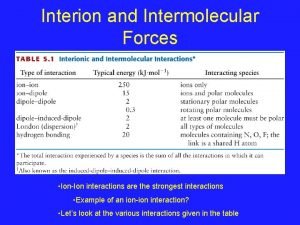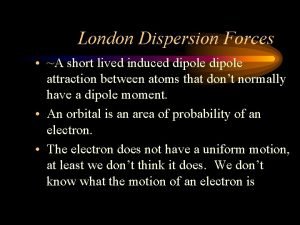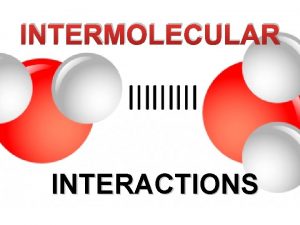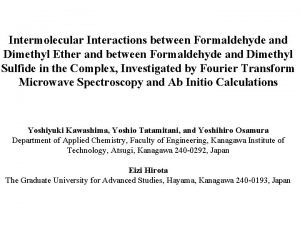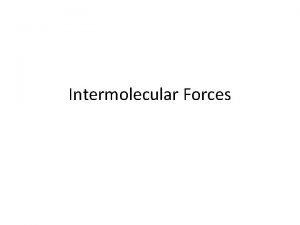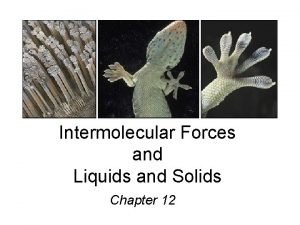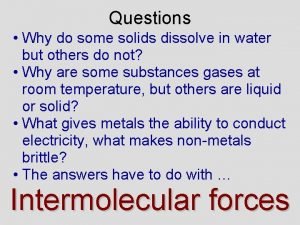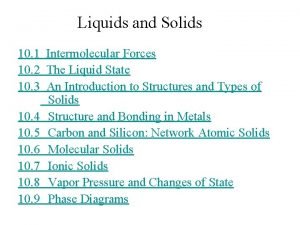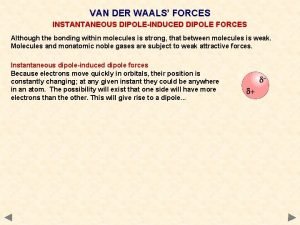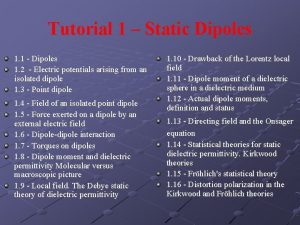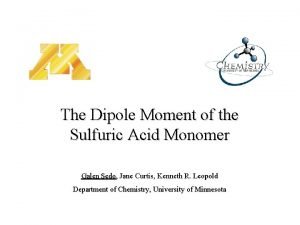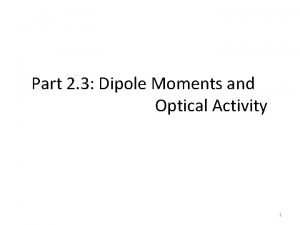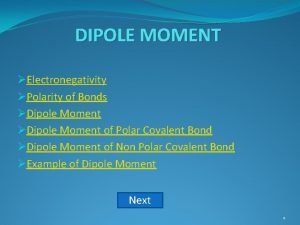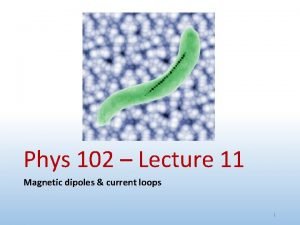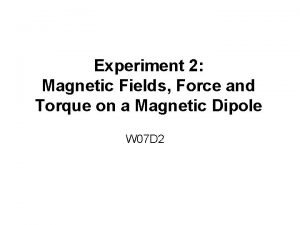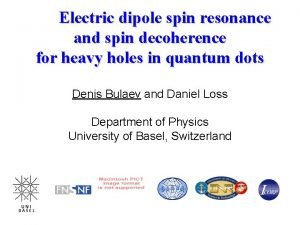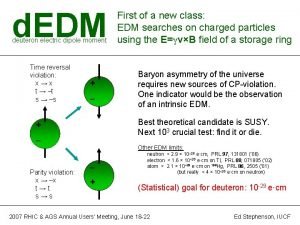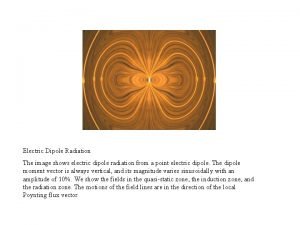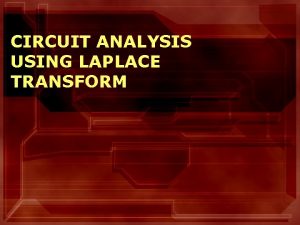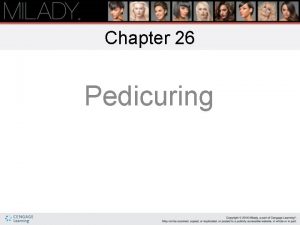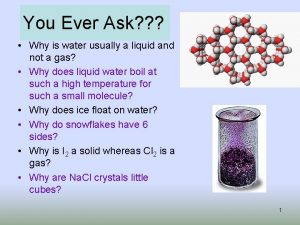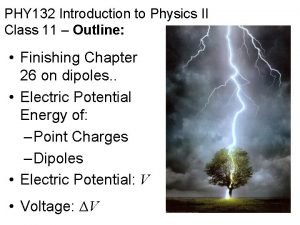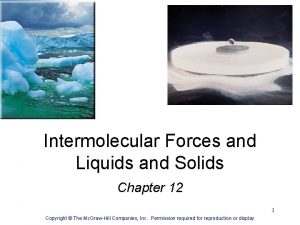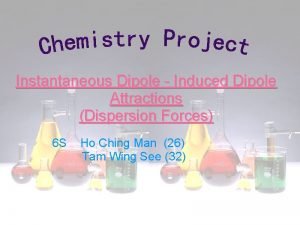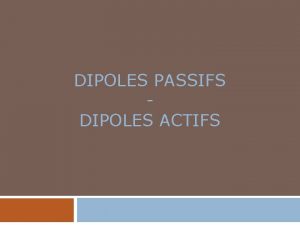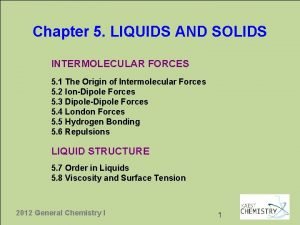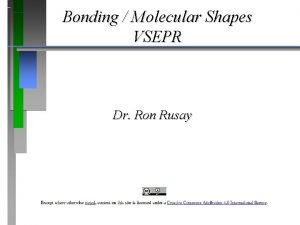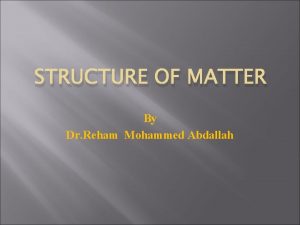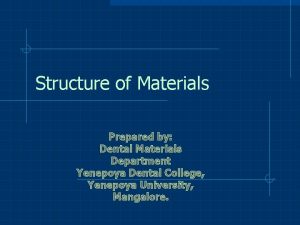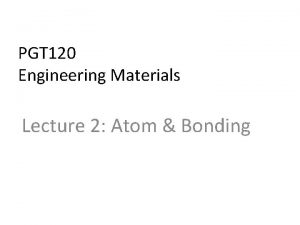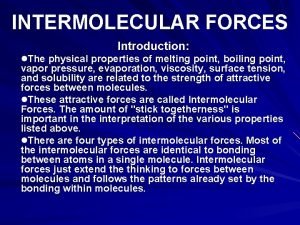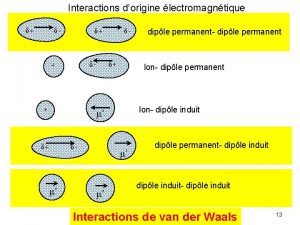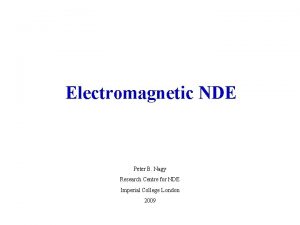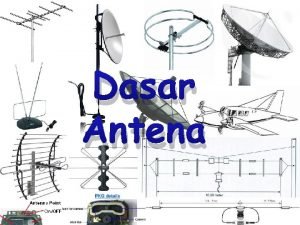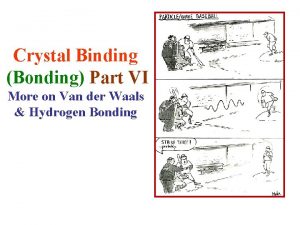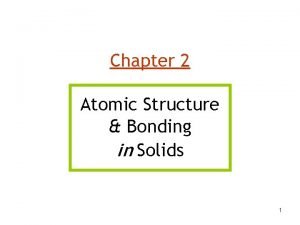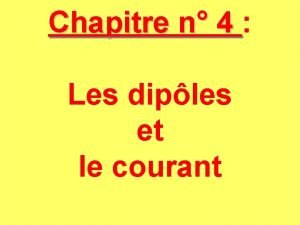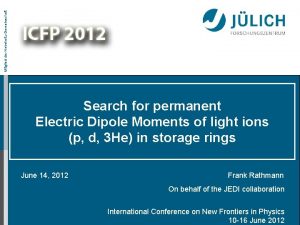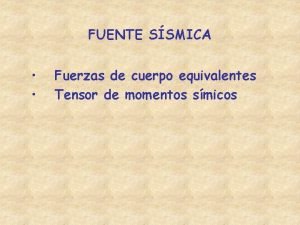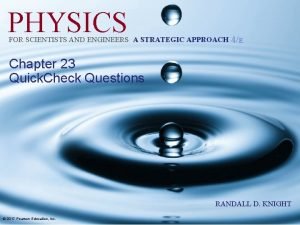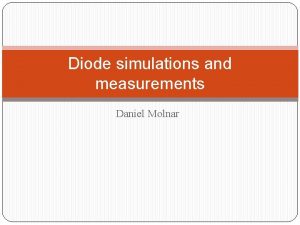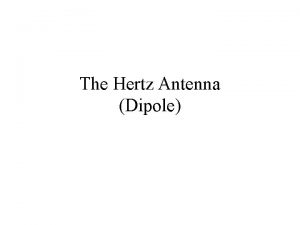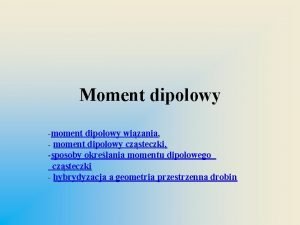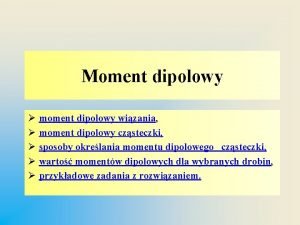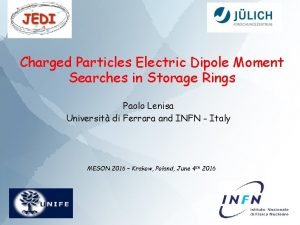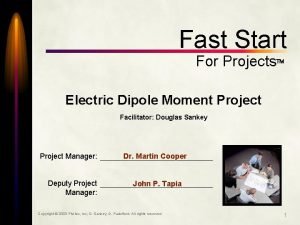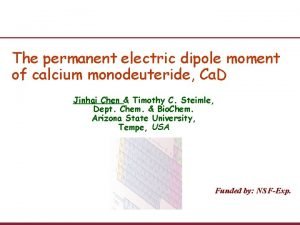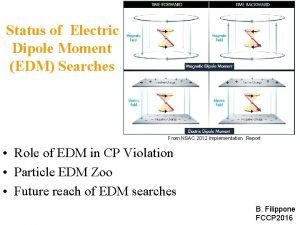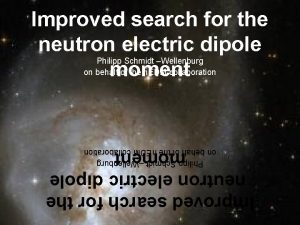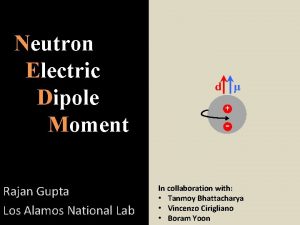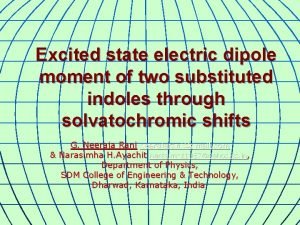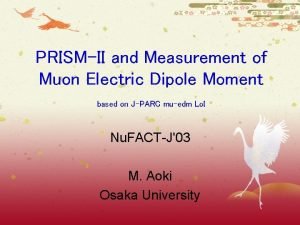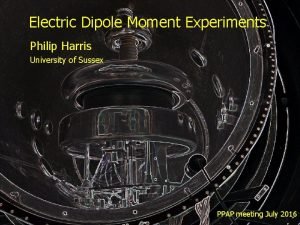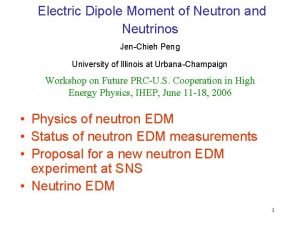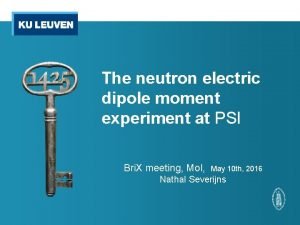Measuring the Electrons Electric Dipole Moment using zerogfactor

































































- Slides: 65

Measuring the Electron’s Electric Dipole Moment using zero-g-factor paramagnetic molecules APS March Meeting, 2006 Neil Shafer-Ray, The University of Oklahoma Funding sources for preliminary research: National Research Council (US) NATO Sf. P (for field measurement. ) OU Office of the Vice President for Research Current funding: National Science Foundation DOE EPSCo. R Laboratory-State Partnership The University of Oklahoma

To all, I am very sorry that I was not able to deliver this talk. My grandmother has passed away a few hours ago and I must return to the United States. Sunday, October 8, 11: 30 pm Neil Shafer-Ray The University of Oklahoma

CP (time reversal) violation K-zero-long decay http: //www. bnl. gov/bnlweb/history/nobel_80. asp The University of Oklahoma

A completely different place to look for CP violation is in the interaction of fundamental particles with external fields. The University of Oklahoma

The study of the magnetic moment of the electron is an integral part of some of the most compelling experiments of the last 100 years. Hans G. Dehmelt Norman Ramsey ion Separated trapping, spectroscopy of a Resonance single Oscillator Beam Gerald Gabrielse II Rabi 1938 trapped electron. resonant line witdths <100 Hz Quantum nondistructive measurement Stern and Gerlach 1922 Magnetic Resonance Prize 1989 STANDARD OF TIME of. Nobel the. Nobel quantum structure of "space quantization" resonant line widths <10 k. Hz a single electron in a magnetic trap g=1 to 10% of (assumed integral spin) Nobel Prize 1944 MAINSTAY MODERN CHEMISTRY STANDARD OF MASS? Nobel Prize 1943 The University of Oklahoma

An EDM proportional to spin would also give CP g = 2. 0023193043617(16) Gabrielse, PRL 2006 gedm = 0. 000000000(5) Commins, PRL, 2004 The University of Oklahoma

- Hinds & coworkers, Yb. F, DAMOP, 2005 Super Sym. Std. Mod. - Commins & coworkers, Tl, PRL, 2002 (Hoogeveen 1990) (Arnowitt 2001) An EDM proportional to spin would also give CP The University of Oklahoma

Outline I. Introduction How was the current experimental limit on the magnitude of the e-EDM obtained? What are some of the current experiments being carried out to measure the e-edm What is the OU group up to? The University of Oklahoma

How the current limit on electron EDM is known Symmetry leads to a ±M degeneracy of any molecule or atom that is not broken by an electric field along the quantization axis. The existence of an electron electric dipole moment would break this symmetry. To search for an Major Difficulty: e-EDM we will structure APrecision background calculations are look for magnetic field not necessary. mimics an EDM. DU=U+M –U-M in a strong E field. The University of Oklahoma

The Commins Experiment with 2 P 1/2 (F=1, M=± 1) Tl For an isolated electron, For an atom or molecule in a strong electric field, for diamagnetic atoms for light atoms/molecules (Schiff's theorem. ) for relativistic (heavy atoms/molecules. ) We want to use heavy paramagnetic atoms or molecues. The University of Oklahoma

The Commins Experiment with 2 P 1/2 (F=1, M=± 1) Tl enhancement factor geometric factors The University of Oklahoma

Graphical Description of the Commins e-EDM Experiment LA SE R RA DI AT IO E N P(q, f) = probability of finding the system In the state M=F when quantization axis is in the direction of q, f. Tl(2 P 1/2 F=1), incoherent combination of Tl(2 P 1/2 F=1), |1, 1>, |1, 0> and |1, -1> states |1, 1> + |1, -1> The University of Oklahoma

EFFECT OF MAGNETIC FIELDS ON THE DISTRIBUTION OF ANGULAR MOMENTUM B Tl(2 P 1/2 F=1), |1, 1> + Exp[i DU t / ] |1, -1> The University of Oklahoma

EFFECT OF MAGNETIC FIELDS ON THE DISTRIBUTION OF ANGULAR MOMENTUM B Bx A small constant field Bx along an axis perpendicular to B has little effect. The University of Oklahoma

EFFECT OF MAGNETIC FIELDS ON THE DISTRIBUTION OF ANGULAR MOMENTUM B Brot A small field Bx along an axis perpendicular to B that rotates with the distribution may have a dramatic effect. The University of Oklahoma

EFFECT OF A MAGNETIC FIELD ON OF ANGULAR MOMENTUM ORIENTATION B A small field Bx along an axis perpendicular to B that rotates with the distribution may have a dramatic effect. The Ramsey beam resonance technique takes advantage of this dependence of the Rabi rotation on the phase of the rotating field. The University of Oklahoma

B R E S LA LA w= DU/ =w. RF The Commins experiment Commins et al, PRL 88, 71805, 2002 SE R

B ER S A L LA w= DU/ w. RF The Commins experiment Commins et al, PRL 88, 71805, 2002 SE R

FLUORESCENCE (LIGHT SEEN) MISMATCH BETWEEN w and w. RF Expected Ramsey resonance signal for n. T = (2 k. T/m)1/2 / 2 L = 140 Hz (m=100 amu , T=500 K, and interaction length L= 1000 mm) The University of Oklahoma

B R E S LA E LA w= DU/ =w. RF(+) The Commins experiment Commins et al, PRL 88, 71805, 2002 SE R

B R E S LA E LA w= DU/ =w. RF(-) The Commins experiment Commins et al, PRL 88, 71805, 2002 SE R

E(-||)B E||B SHIFT GIVES EDM SHIFT SHOWN TO BE ~ 10 -7 OF THE WIDTH!!! GREAT STATISTICS! The University of Oklahoma

limiting systematic error q sinq ≈10 -6 The University of Oklahoma

Measurement of the e-EDM using paramagnetic molecules System (state) Tl (2 P 1/2 F=1) E-field (k. V/cm) m om C 100 s d 10. in Yb. F (X 2 S, F=1) ins H split @ 10 -27 e cm (m. Hz) B@ dlimit 10 -27 e cm tcoherence (ms) (10 -27 e cm) (n. G) 0. 024 3 13 5 3 - 1) Effective electric field is the internal field of the molecule. 2) Idea by Saunders (Atomic Phys, 14 1975, 71). 3) Calculation of shift by N. S. Mosyagin, M. G. Kozlov, A. V. Titov, (J Phys B, 31, L 763) The University of Oklahoma

Effect of the large tensor split (energy dependence on |M|) q Only the projection of B on the E axis contributes to the energy between ±M levels: v The University of Oklahoma

Effect of the large tensor split (energy dependence on |M|) Dq q Only the projection of B on the E axis contributes to the energy between ±M levels: A much less severe problem then the vx. E/c 2 effect. The University of Oklahoma

Differences between an atomic beam and a beam of paramagnetic molecules Beam Expected Flux Tl(F=1, |M|=1) (from oven) 8 × 1015/str/sec Speed Distribution 0 Yb. F(J=1/2, F=1, |M|=1) 6 × 1010/str/sec (from supersonic expansion) 0 400 800 v(m/s) Easy to lose in statistics what one gains in intrinsic sensitivity. The University of Oklahoma

System (state) Tl Commins (2 P 1/2 F=1) Yb. F (X 2 S, F=1) Cs (2 P Hinds (Hinds) Hunter (Weiss) 1/2 F=3) (Gould) (Shafer(X 2 P 1/2, F=1) Ray) Pb. F Hf. F+ (3 D 1 ) (Cornell) Pb. O (De. Mille) (a 3 S, F=1) B@ E-field 10 -27 e cm tcoherence dlimit (k. V/cm) (m. Hz) (ms) (10 -27 e cm) (n. G) shift @ 100 0. 024 3 1. 3 30 (1? ) 10. 13 5 3 4 100? ? 0. 00016 0. 004 0. 00025 0. 005 15 60 -100 12 ~1 volt RF ion trap ~10 ~200 ~103 - . 01 2. 9 1 0. 1 - 2 x 103 60 - ~103 - 500 to 107 103 to 3 - The University of Oklahoma

Cs Atomic Fountain (Provided by Harvey Gould) The University of Oklahoma

The OU Pb. F edm experiment The University of Oklahoma

g factor of Pb. F F=1, |MF|=1, high-field-seeking ground state: g-factor can be tuned to zero! Shafer-Ray, PRA, 73, 34102 The University of Oklahoma

Schematic of Pb. F g=0 measurement optical polarization (create M=0 state) ob e LIF or REMPI detection region (probe M=0 state) pr ob e - pr R Pb. F molecular beam source + am an -R F pu m p high-field region The University of Oklahoma

Schematic of Pb. F g=0 measurement optical polarization (create M=0 state) ob e LIF or REMPI detection region (probe M=0 state) pr ob e - pr R Pb. F molecular beam source + am an -R F pu m p high-field region The University of Oklahoma

First things first: Production and detection of Pb. F Pb / F 2 flow reactor: Operational Temperature 1200 K Pb +Mg. F 2 reactor: Operational Temperature 1200 K Pb +Pb. F 2 reactor: Operational Temperature 1200 K The University of Oklahoma

Schematic of Pb. F g=0 measurement optical polarization (create M=0 state) ob e REMPI detection region (probe M=0 state) pr ob e - pr R Pb. F molecular beam source + am an -R F pu m p high-field region The University of Oklahoma

Current Apparatus for Exploring Pb. F Spectroscopy Nd: YAG 10 ns, 10 Hz tunable dye laser 0. 1 cm-1 resolution Not an ideal detection scheme: Pb. F molecules stay in probe region ~5 ms detection chamber. Time between laser shots: 100 ms Duty cycle: 1/(20, 000) ionization chamber Pb. F Source Chamber The University of Oklahoma

Pb. F+ detection chamber Current Apparatus for Exploring Pb. F Spectroscopy Pb. F ionization chamber Pb. F Source Chamber The University of Oklahoma

Pb. F+ detection chamber Current Apparatus for Exploring Pb. F Spectroscopy Pb. F ionization chamber Pb. F Source Chamber The University of Oklahoma

1+1 X 12 P 1/2 →B 2 S 1/2 REMPI of Pb. F Mc. Raven, Poopalasingam, Shafer-Ray, Chemical Physics Letters, In Progress. 5. 0 4. 0 energy (e. V) (0, 0) band OU data, 2005 Pb. F+ 3. 0 355 -397 nm 2. 0 1. 0 A 2 S 1/2 0. 0 B 2 S 1/2 X 2 P 1/2 280 nm -1. 0 -2. 0 -3. 0 5. 0 7. 0 R(Bohr) The University of Oklahoma

Observation of an ionization threshold for Pb. F Mc. Raven, Poopalasingam, Shafer-Ray, Chemical Physics Letters, In Progress. I. P. 7. 55 e. V The University of Oklahoma

State selective ionization of Pb. F+ via 1+1+1 doubly-resonant multi-photon ionization. 5. 0 WE HAVE DISCOVERED A NEW ELECTRONIC STATE OF Pb. F (tentative assignment: E'4 S 3/2) 4. 0 3. 0 E' 4 S 3/2? 2. 0 energy (e. V) 436. 320 l (X→A) / nm Pb. F+ 1. 0 A 2 S 1/2 X 2 P 1/2 0. 0 -1. 0 -2. 0 -3. 0 436. 612 442. 4 l (A→E') / nm 3. 0 440. 8 5. 0 7. 0 R(Bohr) The University of Oklahoma

Double Resonant Ionization of Pb. F SIMULATION EXPERIMENT f (A→E') / cm-1 f (X→A) / cm-1 22900. 6 22641. 8 22612. 1 22889. 9 The University of Oklahoma

We have used our 0. 1 cm-1 lasers to almost isolate the J=1/2 state! (Impossible with 1 resonant step. ) We now have a blue diode laser and will start scanning with 10 MHz resolution in the next few weeks R 2 -R 21 JX 1 1/2 3/2 7/2 5/2 9/2 R 2 -Q 1 3/2 1/2 R 2 -P 21 3/2 P 1 -R 21 3/2 5/2 We have yet to rotationally cool. (Bigger 5/2 pumps await promised DOE money. Program in limbo until Congress approves the Energy and Water appropriations bill. ) A→E' photon energy (cm-1) The University of Oklahoma

Signal Intensity (a. u. ) X→A Saturation Curve (A→E' fluence at 0. 12 J/cm 2) 5 ~40 m. J/cm 2 of 0. 1 cm-1 light to saturate X→A ionization step at 437 nm. A-state lifetime 3 m. S X→A transition may be saturatuated with ~15 m. W/mm 2 diode laser radiation 0 fluence of X→A laser radiaion (m. J/cm 2) The University of Oklahoma

A→E' Saturation Curve (X→A fluence at 43 m. J/cm 2) Signal Intensity (a. u. ) A→E' step saturated 5 ionization step saturated radiation driving both A→E' and E'→Pb. F+ 0 12 J/cm 2 to saturate A→E'→Pb. F+ ionization step at 441 nm. E' lifetime <5 ns can not be ionized with cw laser radiation fluence of A→E' laser radiaion (J/cm 2) The University of Oklahoma

TIMING FOR OPTIMIZED Pb. F DETECTION 437 nm X→A diode laser radiation. 10 m. W/mm 2 cw 442 nm A→E'→Pb. F+ pulse laser radiation 10 m. J/mm 2, 10 -100 ns 100 -1000 Hz 208 Pb. F 0 2 usec ion signal 6 usec The University of Oklahoma

Current set up. rep rate 10 Hz laser radiation 2 mm (x 0. 1 mm) Pb. F beam The University of Oklahoma

OPTIMIZED DETECTION OF Pb. F rep rate 1000 Hz 100 mm (x 0. 1 mm) Pb. F beam Improvement over current spectra: The University of Oklahoma

p pu m LIF or REMPI detection region (probe M=0 state) pr ob e - pr ob e + n- R F op (c tica re l at po e M lari =0 za st tion R at am e) a high-field region A 2 S 1/2 (F=1) X 1 2 P 1/2 (F=1) M=0 |M|=1 The University of Oklahoma

p pu m LIF or REMPI detection region (probe M=0 state) pr ob e - pr ob e + n- R F op (c tica re l at po e M lari =0 za st tion R at am e) a high-field region A 2 S 1/2 (F=1) X 1 2 P 1/2 (F=1) M=0 |M|=1 The University of Oklahoma

p pu m LIF or REMPI detection region (probe M=0 state) pr ob e - pr ob e + n- R F op (c tica re l at po e M lari =0 za st tion R at am e) a high-field region |M|=1 M=0 400 MHz The University of Oklahoma

p pu m LIF or REMPI detection region (probe M=0 state) pr ob e - pr ob e + n- R F op (c tica re l at po e M lari =0 za st tion R at am e) a high-field region |M|=1 M=0 400 MHz The University of Oklahoma

Requirements for large Rabi population amplitude in Raman pumping from a state A to a state B C A w w+Dw (1) Dw of lasers on resonance. B (2) At least 1 state C that couples to both A and B. (3) A finely tuned ratio of A-C to B-C coupling. The University of Oklahoma

A 2 S 1/2 x^ g 0 g g= =p/2 EDC ^ ^ k = BRF, effective X 1 2 P 1/2 M=0 |M|=1 PM=0 P|M|=1 The University of Oklahoma

p pu m LIF or REMPI detection region (probe M=0 state) pr ob e - pr ob e + n- R F op (c tica re l at po e M lari =0 za st tion R at am e) a high-field region The University of Oklahoma

p pu m LIF or REMPI detection region (probe M=0 state) pr ob e - pr ob e + n- R F op (c tica re l at po e M lari =0 za st tion R at am e) a high-field region The University of Oklahoma

p pu m LIF or REMPI detection region (probe M=0 state) pr ob e - pr ob e + n- R F op (c tica re l at po e M lari =0 za st tion R at am e) a high-field region PROBE+ The University of Oklahoma

p pu m LIF or REMPI detection region (probe M=0 state) pr ob e - pr ob e + n- R F op (c tica re l at po e M lari =0 za st tion R at am e) a high-field region PROBE+ The University of Oklahoma

p pu m LIF or REMPI detection region (probe M=0 state) pr ob e - pr ob e + n- R F op (c tica re l at po e M lari =0 za st tion R at am e) a high-field region PROBE+ The University of Oklahoma

p pu m LIF or REMPI detection region (probe M=0 state) ^ small, E even ^ reverse sign with changing E. pr ob e - pr ob e + n- R F op (c tica re l at po e M lari =0 za st tion R at am e) a high-field region PROBEThe University of Oklahoma

Using Ramsey fringes to lock the electric field: w. RF 1 fixed to a frequency standard. w. RF 2=w. RF 1+Dw RF 1 RF 2 zero crossing independent of ±M phase Q S S The University of Oklahoma

A totally different idea: Guided Pb. F molecules in a Coaxial cable q. EDM LIF Raman-RF polarizatiing laser radiation imaging detector 1 to 100 meters Disadvantages: Must use LIF detection g=0. 017 (not zero) Advantage: long (~1 second) coherence time LIF image The University of Oklahoma

Conclusions • We have found a system for which the effect of background magnetic fields may be suppressed by seven orders of magnitude. • We have developed a source of Pb. F as well as sensitive state selective REMPI of the molecule. • We are designing a beam machine to take advantage of this new system. The University of Oklahoma

THANKS TO: Undergraduate Students: Chris Crowe, Dustin Combs, Chris Bares Graduate Students: Chris Mc. Raven , Sivakumar Poopalasingam, Milinda Rupasinghe Professor George Kalbfleisch: March 14, 1931 - September 12 2006 The University of Oklahoma

And thanks to the e-EDM COLLABORATION The University of Oklahoma Neil Shafer-Ray Kim Milton John Furneaux Petersburg Nuclear Physics Institute Victor Ezhov Mikhail Kozlov University of Latvia Marcis Auzinsch U Cal Berkeley Dmitry Budker BNL Chemistry Greg Hall Trevor Sears The University of Oklahoma
 Ion-dipole interaction example
Ion-dipole interaction example Coulomb
Coulomb Dispersion forces vs dipole dipole
Dispersion forces vs dipole dipole Ion induced dipole example
Ion induced dipole example Dispersion forces vs dipole dipole
Dispersion forces vs dipole dipole Capillary action
Capillary action Formaldehyde intermolecular forces
Formaldehyde intermolecular forces Intermolecular forces of attraction
Intermolecular forces of attraction Liquid properties
Liquid properties London dispersion forces induced dipole
London dispersion forces induced dipole Dipole-dipole attractions
Dipole-dipole attractions Strongest to weakest bonds
Strongest to weakest bonds Vapor pressure and intermolecular forces
Vapor pressure and intermolecular forces Intermolecular forces of attraction
Intermolecular forces of attraction Instantaneous dipole
Instantaneous dipole Polarizability dipole moment
Polarizability dipole moment H2so4 dipole moment
H2so4 dipole moment Dipole moment of thulium nucleus
Dipole moment of thulium nucleus Magnetic dipole moment
Magnetic dipole moment Permanent dipole moment
Permanent dipole moment Dipole moment definition chemistry
Dipole moment definition chemistry Magnetic moment
Magnetic moment Magnetic moment
Magnetic moment Direction of dipole moment
Direction of dipole moment Contoh soal dipol listrik
Contoh soal dipol listrik Electric dipole spin resonance
Electric dipole spin resonance Electric dipole
Electric dipole Potential of conductor
Potential of conductor Electric field of dipole
Electric field of dipole Electric dipole image
Electric dipole image Electric field formula voltage
Electric field formula voltage Electric potential from electric field
Electric potential from electric field Electric field from electric potential
Electric field from electric potential A suitable electric pump in an electric circuit is a
A suitable electric pump in an electric circuit is a Chapter 21 electric charge and electric field
Chapter 21 electric charge and electric field Chapter 21 electric charge and electric field
Chapter 21 electric charge and electric field Electric force
Electric force Dc o/d per item charge
Dc o/d per item charge Electric charges and electric forces lesson outline
Electric charges and electric forces lesson outline Capacitor laplace
Capacitor laplace Chapter 26 pedicuring review questions
Chapter 26 pedicuring review questions London dispersion forces induced dipole
London dispersion forces induced dipole Dipole squall
Dipole squall What is the dipole’s mechanical energy?
What is the dipole’s mechanical energy? Ion induced dipole examples
Ion induced dipole examples Induced dipole
Induced dipole Un dipôle passif
Un dipôle passif Ion dipole forces
Ion dipole forces Vsepr ionic compounds
Vsepr ionic compounds Fluctuating dipole
Fluctuating dipole Fluctuating dipole
Fluctuating dipole Fluctuating dipole
Fluctuating dipole Fluctuating dipole
Fluctuating dipole Permanention
Permanention Monopole dipole
Monopole dipole Jenis antena dipole
Jenis antena dipole Dipole permanent
Dipole permanent Secondary bonds
Secondary bonds Dipole symétrique
Dipole symétrique Fluctuating dipole
Fluctuating dipole Dipole permanent
Dipole permanent Dipole chart
Dipole chart Compensated linear vector dipole
Compensated linear vector dipole Dipole
Dipole An electron is in the plane that bisects a dipole
An electron is in the plane that bisects a dipole Dipole
Dipole
